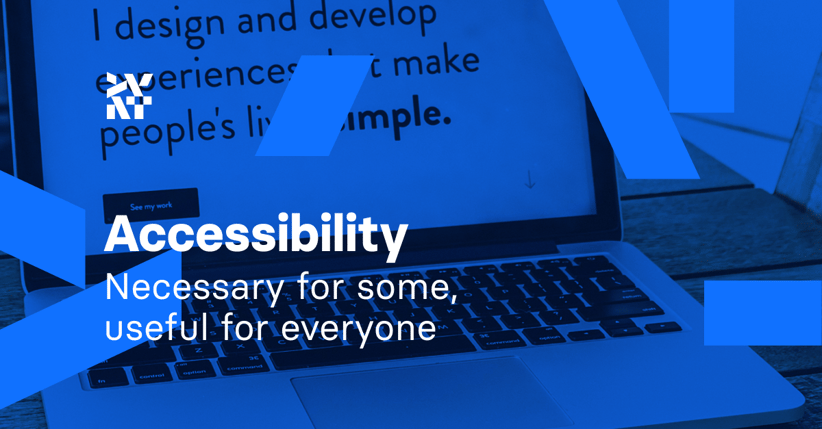Accessibility of services is not about being nice and caring. It's about doing the right thing, especially in the online world where creating a barrier-free environment for people with special needs can yield significant benefits. Despite the common perception, digital exclusion does not only affect people with disabilities. Accessible solutions are ones that can be used and understood by everyone regardless of their preferences or disability level. In addition, healthy people can also benefit from accessible digital services.
Social groups at risk of digital exclusion can take advantage of accessibility
According to WHO statistics, there are more than 1 billion people with some form of disability around the world. That makes up about 15% of the total population. In the U.S. alone, 19.9 million people, 8.2% of the population, have difficulty lifting their arms or grasping objects, which can significantly hinder using a mouse or keyboard. More than 15 million people, 6.3%, suffer from cognitive, mental, or emotional impairment. Visual impairment affects 8.1 million people,3.3%, and hearing impairment affects 7.6 million people, 3.1%).
When it comes to Poland, there are more than 3 million people who have a disability certificate. In fact, there are many more people, 4 to 7 million, with various disabilities. This includes people who are partially sighted or blind, deaf or hard of hearing, and people with color vision disorders, including color blindness. Other disabilities include motor impairment, photosensitive epilepsy, cognitive disorders, and ADHD. The rate of these rose sharply during the pandemic. About 10% of the population has symptoms of dyslexia and struggles with writing skills.
Another large group at risk of digital exclusion are senior citizens. Currently, there are almost 9 million people in Poland over the age of 60. That figure is expected to rise to 10.7 million by 2030 to account for almost 30% of the population. This clearly indicates that Poland's population is aging.
It should be remembered that it’s these senior citizens that often include a large number of people with disabilities. Based on these statistics, we can clearly see that we’re dealing with a large number of users. However, it should be taken into account that the data presented only include individuals with a disability certificate that isn’t necessarily held by every disabled person.
It’s assumed that up to 20% of the population suffers from digital exclusion. This represents a significant number of potential customers of online shops since, just like people without disabilities, they tend to buy almost everything online. They order pizza, groceries, everyday necessities, household appliances, air purifiers, watches, and books.
Brands often spend huge amounts of money on marketing campaigns to attract minor target groups while ignoring a large number of potential new customers. From a business perspective, this is a mistake because they’re missing out on potential revenue. Brands that are accessible are much more likely to attract these groups of customers and boost their loyalty.
It should be taken into account that, in some cases, the “disability” may be temporary. Some examples include broken limbs, migraines, eye fatigue, the need to use a mobile device in a place where you have to keep quiet, etc. In these situations, each of us can find ourselves in a position when we become “disabled” to a certain extent. This hinders, or even completely prevents, the effective navigation of websites. With the help of assistive technologies, we can operate a computer with one hand or without using a keyboard or a mouse, for example, to shop online.
Additional advantages of accessible websites
- Compliance with Polish and European law. In Poland, relevant legal obligations are imposed on public institutions and telecommunication companies as well as entities benefiting from EU funds. The upcoming EU directive contained in the European Accessibility Act (EAA), comprehensive works which are currently underway in the EU, will impose a responsibility on commercial entities to meet Web Content Accessibility Guidelines (WCAG). The EAA will contain standardized accessibility requirements for selected services and products. It applies mainly to computer hardware and operating systems, self-service terminals, electronic communication services, like emergency calls, audio-visual services, passenger transport services, banking services, eBooks, and eCommerce.
- Universal access to digital services in various situations. This includes for people with disabilities, for healthy people using their mobile devices in harsh light, for the aging population, for a person who has lost their glasses but urgently needs to send an important email, and many others. Each of us can temporarily feel some kind of "disability" when we least expect it that will cause us to have problems with using digital services.
- SEO and better search results. Search engines, just like screen readers used by blind people, need appropriate text structure to meet WCAG requirements. Accessibility principles related to page titles, headings, alternative texts, transcriptions of films, and sound recordings can help increase a website's position on a search engine and generate more traffic. It’s worth investing in better accessibility simply for the sake of better SEO positioning.
- Easier and cheaper modifications. Accessibility translates into optimal, better-quality source code, faster operation, and easier modification of websites. A code that is compliant with the standards is much easier to edit for developers. This speeds up work and makes website modifications less expensive. The steady development of online technologies forces major or minor modifications every so often. These are certainly less costly for websites created based on accessibility principles. If the code doesn't follow consistent rules, major modifications forced by the dynamic changes in the tech market can entail significant costs. This can include the need to completely recreate the website.
- Usability. The more accessible the website, the more useful it is and the more advantages it offers for users and the owner. Ease of use, internal logic, and legibility of various elements, such as descriptive links, are the basic aspects that facilitate and make for more pleasant website navigation. It also creates a positive impression on the user. It’s worth ensuring accessibility for the sake of better usability.
- EU subsidies. In some cases, you may be eligible to receive EU funding for the creation of your website. The condition that must be fulfilled is that the website must be created based on the principles of WCAG that contain a set of rules prepared by the World Wide Web Consortium (W3C) . For example, website forms should have a specific look and functionalities in terms of feedback, design of controls, descriptions, contrasting focus, data grouping, etc.
- A business advantage over competitors. Offering universal services accessible to everyone is not yet a standard and is actually quite rare at present. This can be used as a business advantage that can generate added value for the owner’s brand image.
Universal accessibility
The benefits of having a website accessible to everyone are indisputable. That’s why more and more online shops are adapting to WCAG standards to ensure that their services are compliant with current legislation, simpler, and less expensive to modify. To put it in simple terms: it pays off. Even if blind, deaf, or otherwise disabled people do not visit the website, everyone, including the owner, will benefit from accessible services.
Published May 17, 2022











